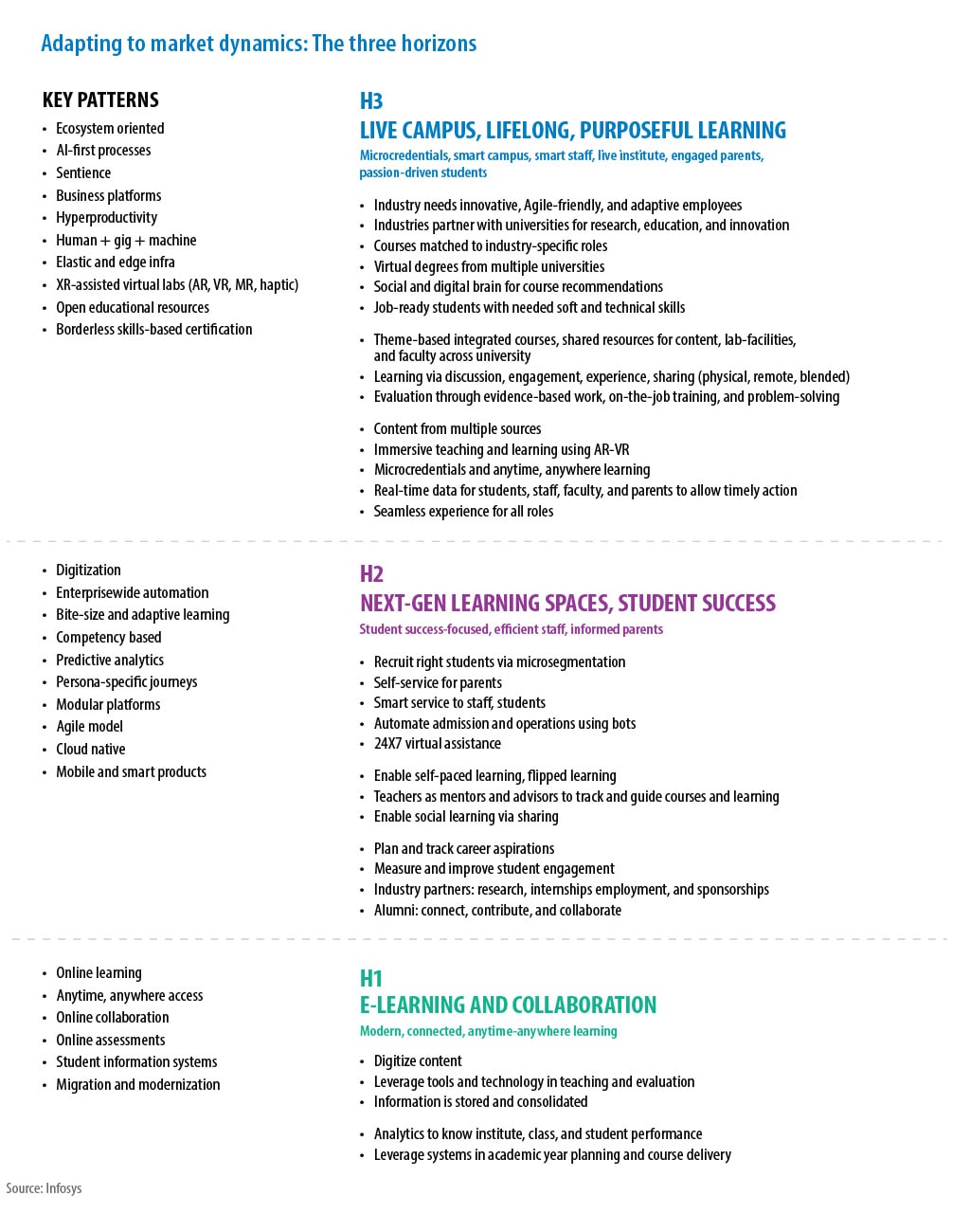Education
Student retention and future success have been the main objectives for most educational institutions, but that often requires personalized learning. Universities do this effectively but often with relatively small teacher-to-student ratios and at a high cost. Technology holds great promise to engage students and deliver personalized learning at scale, even at the corporate training level. However, most institutions have not yet embarked on their digitization journey — a needed step to expand learning beyond classroom limits.
H3
LIVE CAMPUS, LIFELONG, PURPOSEFUL LEARNING
Microcredentials, smart campus, smart staff, live institute, engaged parents, passion-driven students
Key Patterns
- Ecosystem oriented
- AI-first processes
- Sentience
- Business platforms
- Hyperproductivity
- Human + gig + machine
- Elastic and edge infra
- XR-assisted virtual labs (AR, VR, MR, haptic)
- Open educational resources
- Borderless skills-based certification
Characteristics
- Industry needs innovative, Agile-friendly, and adaptive employees
- Industries partner with universities for research, education, and innovation
- Courses matched to industry-specific roles
- Virtual degrees from multiple universities
- Social and digital brain for course recommendations
- Job-ready students with needed soft and technical skills
- Theme-based integrated courses, shared resources for content, lab-facilities, and faculty across university
- Learning via discussion, engagement, experience, sharing (physical, remote, blended)
- Evaluation through evidence-based work, on-the-job training, and problem-solving
- Content from multiple sources
- Immersive teaching and learning using AR-VR
- Microcredentials and anytime, anywhere learning
- Real-time data for students, staff, faculty, and parents to allow timely action
- Seamless experience for all roles
H2
NEXT-GEN LEARNING SPACES, STUDENT SUCCESS
Student success-focused, efficient staff, informed parents
H1
E-LEARNING AND COLLABORATION
Modern, connected, anytime-anywhere learning
Key trends across education subdomains
Trend 1
Improved prospective student experience
Changes in the global economy — such as financial crises and health outbreaks — have introduced new challenges to institutions and learners. These lead to reduced federal funding, technology challenges, shifting enrollment patterns, travel restrictions, and socioeconomic issues regarding student recruitment for college admissions.
Trend 2
Digitized admissions and personalized onboarding
The recent move toward test-optional admissions policies have encouraged traditionally underrepresented students to apply to more selective colleges. That has, in turn, generated more pressure on admissions offices to process and respond to applications quickly.
Trend 3
Comprehensive faculty information management
New instructional models and innovative uses of technology allow higher education faculty to increasingly serve as coaches, advisors, and instructional leads.
Trend 4
Smart academic planning
The latest trends in credentialing are certificates, badges, stackable credentials, job-related curricula, and micro- and nanodegrees. They disrupt the reliance on traditional degrees and provide students with new alternatives.
Trend 5
Next-generation learning
Personalized learning caters to diverse learning styles and needs. Advancements in technology allow institutions to deliver individualized content based on student preferences such as time, location, and mode of delivery.
Trend 6
Advanced student engagement
Institutions are leveraging cloud-based software systems and software-as-a-service to create personalized learning experiences and to manage student data. Institutions are defining the data-capture process for learning situations and administrative processes; thus, over time, a body of data is built.
Trend 7
Digital process automation
Institutions are consolidating multiple support channels (email, chat, phone, web) under a single umbrella to help students, parents, and staff easily raise service requests. This allows optimization of support staff's time and efforts, while effectively supporting the users from multiple channels.
Trend 8
Alumni engagement
Institutions can gather more engagement data from social media interactions, email communications, mentor-mentee collaboration, and volunteer participation. Digitization of alumni engagement offers advancement teams the essential knowledge they require to make smarter decisions and develop stronger alumni relationships.
Trend 9
Live institution
The ongoing expansion of IoT — combined with the steady rise of 5G — will greatly increase the number of devices and applications that security teams need to protect. Institutions' integrated risk management programs enable digital innovation through the establishment of comprehensive planning and governance groups.
Trend 10
Advanced project and program management
The higher education community is under significant pressure to change in all sorts of ways. Initiatives include efforts to become more operationally efficient and effective, improve student outcomes, increase access to higher education, control costs, recruit and retain top faculty and researchers, and many more.
Download Insights

Subscribe
To keep yourself updated on the latest technology and industry trends subscribe to the Infosys Knowledge Institute's publications
Count me in!













